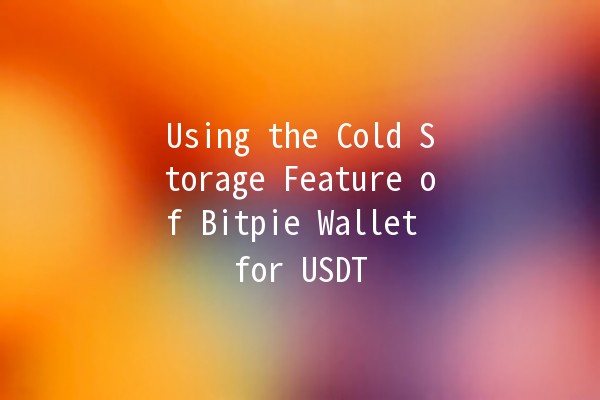




In the everevolving world of cryptocurrency, security remains a paramount concern for users, especially for assets like Tether (USDT). As digital assets continue to gain traction, methods to protect them have also developed. One such method is the use of cold storage, an essential feature provided by wallets like Bitpie. This article will delve into the cold storage functionality of Bitpie Wallet for USDT, offering practical tips to enhance your security and usage efficiency.

Cold storage refers to the practice of keeping cryptocurrency assets offline, disconnected from the internet, which significantly reduces the risk of hacking or unauthorized access. Unlike hot wallets, which are online and convenient for transactions but vulnerable to cyber threats, cold storage solutions prioritize security for longterm asset holding.
A stablecoin like USDT is often used for trading and transferring value across platforms. However, with its growing prominence, it becomes a target for cybercriminals. By leveraging cold storage:
To start utilizing the cold storage feature of Bitpie Wallet for your USDT, you must first install the wallet on a secure device. Here are some essential steps:
Once your wallet is set up, transferring USDT to cold storage is a straightforward process:
Navigate to the wallet interface, select USDT, and initiate a transfer.
Choose a cold storage option, whether it's a hardware wallet or an offline software wallet.
Example: If using a hardware wallet, connect it to your device, create an address, and send your USDT from the Bitpie Wallet to this address.
As with any financial service, the security realm is continuously changing. Therefore, regularly update your Bitpie Wallet and associated software.
Monitor for software updates and apply them immediately.
Consider changing your backup phrases periodically to enhance security.
Creating backups is a critical step in securing your USDT in cold storage.
Follow Bitpie’s recommendations for creating backups of your wallet and the cold storage setup.
Example: Store copies of your backup phrase in multiple secure locations, such as a safe deposit box.
Creating strong, unique passwords for your wallets and associated email accounts is imperative.
Utilize a password manager to generate and store complex passwords safely.
Example: A password like aS3&fjxKl@P9!#uG is incredibly secure compared to simple passwords like “123456”.
Whenever possible, enable 2FA on your exchange accounts and any wallets that support it.
2FA adds an extra layer of security by requiring a second form of verification for transactions or account changes.
Example: Use an app like Google Authenticator or Authy to manage your 2FA codes securely.
Keeping track of your cold storage setup is as important as initial security measures.
Cold storage options include hardware wallets (like Ledger or Trezor) and paper wallets, where private keys are printed and stored offline. Each option has its advantages; hardware wallets often provide enhanced security features and user interfaces.
Always purchase hardware wallets from reputable sources. Additionally, make sure to keep the recovery seed offline and secured in multiple locations to prevent loss. Periodically check for firmware updates from the manufacturer to safeguard against vulnerabilities.
Yes, provided you have secured your backup phrase safely. You can usually recover your wallet by entering this backup phrase into the wallet interface. If the backup phrase is lost, recovering the funds may become impossible.
While cold storage significantly reduces risks, it's wise not to keep all your assets in one place. Diversifying storage methods (like using both cold and hot wallets) can help manage risks effectively.
Withdrawal speed depends on your method of accessing cold storage. For hardware wallets, connecting to the internet and initiating a transfer can take several minutes. With good practice, you can always prepare your transactions in advance.
Most cold storage transfers themselves do not have fees. However, transferring USDT out from an exchange or other wallets may incur network or transaction fees.
To get the most out of Bitpie Wallet's cold storage functionality, consider the following best practices:
Stay Informed: Regularly read updates regarding both Bitpie and the broader crypto sector to stay ahead of potential security threats.
Network with the Community: Engaging with forums and online communities can provide insights and tips from other users.
Educate Yourself on Trends: Understanding trends in cryptocurrency security can prepare you and your assets for future developments.
By adequately implementing these tips, you'll be better equipped to manage your USDT safely and efficiently using Bitpie Wallet's cold storage feature. The future of such assets involves intricate strategies for security and access, and embracing methods like cold storage is integral to navigating the landscape of cryptocurrency.